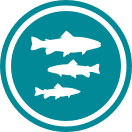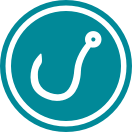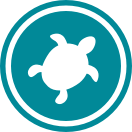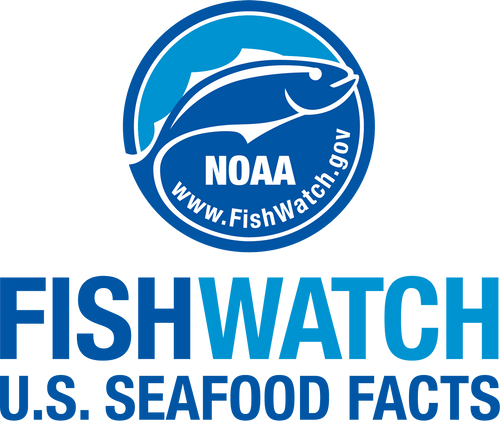Scup
 Scup. Credit: NOAA Fisheries
Scup. Credit: NOAA Fisheries
Scup. Credit: NOAA Fisheries
About the Species
 Scup. Credit: NOAA Fisheries
Scup. Credit: NOAA Fisheries
Scup. Credit: NOAA Fisheries
The scup fishery in the U.S. operates from Maine to Cape Hatteras, North Carolina. Scup undergo an extensive migration between coastal waters in the summer and offshore waters (outer continental shelf) in winter. They migrate offshore and south in the fall, returning north and inshore to coastal areas and bays in spring. The scup fishery predominantly uses trawls or handlines, but other gear includes longline, rod and reel, pot, trap, gillnet, spear, and dredge. The market for scup is for human consumption. U.S. wild-caught scup is a smart seafood choice because it is sustainably managed and responsibly harvested under U.S. regulations. Implementing regulations are found at 50 CFR part 648 subpart H.

Population
The Atlantic coast stock is not overfished.

Fishing Rate
The Atlantic coast stock is not subject to overfishing.

Habitat Impact
Otter trawls can impact bottom habitat. Scup are mainly harvested over sand and mud habitats, which appear to be more resilient to the effects of trawling than more structured habitats, such as coral.

Bycatch
Regulations are in place to minimize bycatch.
Population Status
- There are two stocks of scup: Mid-Atlantic/New England and South Atlantic. According to the most recent stock assessments:
- The Atlantic coast stock is not overfished and not subject to overfishing (2023 stock assessment). Summary stock assessment information can be found on Stock SMART.
- In the South Atlantic, scup is contained in the South Atlantic Porgy Complex. Scientists have not assessed the Porgy Complex, so the population and overfishing status are unknown.
- With greatly improved reproduction and survival rates and low fishing rates since 1998, Mid-Atlantic spawning stock biomass (a measure of the amount of scup able to reproduce) has steadily increased since the mid-1990s.
Appearance
- Scup are deep-bodied (deeper from back to belly than they are wide).
- They are dusky brown with bright silvery reflections below and spiny fins.
- Adult fins are mottled with dark brown, and young scup fins may be faintly barred.
- Scup’s front teeth are very narrow, almost conical, and they have two rows of molars in the upper jaw.
- Longspine porgy look similar to scup, but can be easily identified by the elongated spines on their backs.
Biology
- Scup grow slowly, up to about 20 inches long and 4 pounds.
- They can live a relatively long time, up to about 20 years.
- Scup are able to reproduce when they reach age 2, when they’re about 8 inches long.
- They spawn over weedy or sandy areas in southern New England from Massachusetts Bay south to the New York Bight from May through August, with peak activity in June.
- Individual scup spawn once a year.
- Most fish spawn at night, but scientists believe scup spawn in the morning.
- Females release an average of 7,000 eggs, which are fertilized externally.
- Scup are browsers—they nibble on invertebrates that live on the ocean bottom.
- They are able to grasp food with their incisors and crush hard-shelled animals with their strong molars.
- A variety of plankton-eaters—such as medusae, crustaceans, and fish—prey on scup larvae.
- A number of fish and shorebirds prey on juvenile and adult scup.
Where They Live
Range
- Scup are found in the Northwest Atlantic Ocean, primarily between Cape Cod, Massachusetts, and Cape Hatteras, North Carolina.
Habitat
- Scup eggs and larvae are found in the water column in coastal waters during warmer months.
- As larvae mature, they settle to the seafloor and develop into juveniles.
- Juveniles live in a variety of habitats including rocky ledges, artificial reefs, mussel beds, sand, silty sand, shell, mud bottoms, and eelgrass.
- During the summer and early fall, juveniles and adults are common in large estuaries, open sandy bottoms, and structured habitats such as mussel beds, reefs, or rock rubble.
- Scup migrate north and inshore to spawn in the spring, then migrate south and offshore in autumn as the water cools, arriving by December in offshore areas where they spend the winter.
Fishery Management
- NOAA Fisheries, the Mid-Atlantic Fishery Management Council, and the Atlantic States Marine Fisheries Commission cooperatively manage the scup fishery north of Cape Hatteras, North Carolina.
- Individual states may set different regulations for the commercial scup fishery. Where state measures differ from federal regulations, federally permitted fishery participants must adhere to the more restrictive measures.
- Managed under the Summer Flounder, Scup, and Black Sea Bass Fishery Management Plan:
- Annual commercial quota is divided into three harvest periods: Winter I (January–April), Summer (May–October), and Winter II (November–December).
- The Commission manages the summer quota with individual state quotas.
- NOAA Fisheries monitors commercial harvests and closes the federal scup fishery when the quotas are reached.
- Minimum size limits to prevent the harvest of young fish that likely haven’t yet reproduced.
- Minimum mesh size requirements for trawl nets to reduce bycatch of undersized scup.
- Scup pots and traps must have degradable hinges and escape vents to reduce bycatch and to prevent “ghost fishing” (when a lost trap continues to catch fish or lobster).
- A moratorium on entry into the fishery.
- Recreational anglers are subject to an annual harvest limit, minimum fish sizes, possession limits, and open harvest periods.
- NOAA Fisheries and the South Atlantic Fishery Management Council manage the black sea bass fishery south of Cape Hatteras, North Carolina.
- Managed under the South Atlantic Snapper Grouper Fishery Management Plan.
- A small amount of scup is harvested in the South Atlantic. Scup are managed as part of a complex with several other porgy species.
- The Snapper Grouper FMP requires fishermen to have a permit and to comply with gear restrictions. The complex is regulated through commercial and recreational annual catch limits and accountability measures to ensure overfishing does not occur.
Harvest
- Commercial fishery:
- In 2022, commercial landings of scup totaled 12 million pounds and were valued at $10 million, according to the NOAA Fisheries commercial fishing landings database.
- The top five states for commercial scup landings are New York, Rhode Island, New Jersey, Connecticut, and Massachusetts.
- Gear types, habitat impacts, and bycatch:
- About 75 percent of commercial scup landings are caught with otter trawls.
- Otter trawls can impact bottom habitat. Scup are mainly harvested over sand and mud habitats, which appear to be more resilient to the effects of trawling than more structured habitats, such as gravel or coral.
- Otter trawls can incidentally catch undersized scup. Minimum mesh size regulations and time and area restrictions for trawl nets help to reduce incidental catch of undersized scup.
- The rest of the commercial harvest is mainly caught with floating traps and hand lines.
- Floating traps are anchored to the bottom in inshore waters in the migratory path of scup. Fishermen check on the traps daily to sort their catch.
- Paired trawl nets, pound nets, and pots catch a small percentage of the commercial harvest.
- Recreational fishery:
- In 2022, recreational anglers landed 17.3 million pounds of scup, according to the NOAA Fisheries commercial fishing landings database.
- The top three states for recreational scup landings are New York, Connecticut, and Rhode Island.
- In the Mid-Atlantic and southern New England, the recreational scup fishery is managed under separate regulations for federal and state waters.
- Managers set regulations for the recreational fishery annually. They include a combination of an annual catch quota, minimum size limits, bag limits, and fishing seasons.
- For-hire recreational vessels must have a permit to fish in federal waters.
- In the South Atlantic, there is a limit on the amount of scup recreational fishermen can keep and restrictions on the type of gear they can use.
Last updated by NOAA Fisheries on 09/06/2024
- Scup are found in the Northwest Atlantic Ocean, primarily between Cape Cod, Massachusetts, and Cape Hatteras, North Carolina.
- Scup eggs and larvae are found in the water column in coastal waters during warmer months.
- As larvae mature, they settle to the seafloor and develop into juveniles.
- Juveniles live in a variety of habitats including rocky ledges, artificial reefs, mussel beds, sand, silty sand, shell, mud bottoms, and eelgrass.
- During the summer and early fall, juveniles and adults are common in large estuaries, open sandy bottoms, and structured habitats such as mussel beds, reefs, or rock rubble.
- Scup migrate north and inshore to spawn in the spring, then migrate south and offshore in autumn as the water cools, arriving by December in offshore areas where they spend the winter.
Fishery Management
- NOAA Fisheries, the Mid-Atlantic Fishery Management Council, and the Atlantic States Marine Fisheries Commission cooperatively manage the scup fishery north of Cape Hatteras, North Carolina.
- Individual states may set different regulations for the commercial scup fishery. Where state measures differ from federal regulations, federally permitted fishery participants must adhere to the more restrictive measures.
- Managed under the Summer Flounder, Scup, and Black Sea Bass Fishery Management Plan:
- Annual commercial quota is divided into three harvest periods: Winter I (January–April), Summer (May–October), and Winter II (November–December).
- The Commission manages the summer quota with individual state quotas.
- NOAA Fisheries monitors commercial harvests and closes the federal scup fishery when the quotas are reached.
- Minimum size limits to prevent the harvest of young fish that likely haven’t yet reproduced.
- Minimum mesh size requirements for trawl nets to reduce bycatch of undersized scup.
- Scup pots and traps must have degradable hinges and escape vents to reduce bycatch and to prevent “ghost fishing” (when a lost trap continues to catch fish or lobster).
- A moratorium on entry into the fishery.
- Recreational anglers are subject to an annual harvest limit, minimum fish sizes, possession limits, and open harvest periods.
- NOAA Fisheries and the South Atlantic Fishery Management Council manage the black sea bass fishery south of Cape Hatteras, North Carolina.
- Managed under the South Atlantic Snapper Grouper Fishery Management Plan.
- A small amount of scup is harvested in the South Atlantic. Scup are managed as part of a complex with several other porgy species.
- The Snapper Grouper FMP requires fishermen to have a permit and to comply with gear restrictions. The complex is regulated through commercial and recreational annual catch limits and accountability measures to ensure overfishing does not occur.
Harvest
- Commercial fishery:
- In 2022, commercial landings of scup totaled 12 million pounds and were valued at $10 million, according to the NOAA Fisheries commercial fishing landings database.
- The top five states for commercial scup landings are New York, Rhode Island, New Jersey, Connecticut, and Massachusetts.
- Gear types, habitat impacts, and bycatch:
- About 75 percent of commercial scup landings are caught with otter trawls.
- Otter trawls can impact bottom habitat. Scup are mainly harvested over sand and mud habitats, which appear to be more resilient to the effects of trawling than more structured habitats, such as gravel or coral.
- Otter trawls can incidentally catch undersized scup. Minimum mesh size regulations and time and area restrictions for trawl nets help to reduce incidental catch of undersized scup.
- The rest of the commercial harvest is mainly caught with floating traps and hand lines.
- Floating traps are anchored to the bottom in inshore waters in the migratory path of scup. Fishermen check on the traps daily to sort their catch.
- Paired trawl nets, pound nets, and pots catch a small percentage of the commercial harvest.
- Recreational fishery:
- In 2022, recreational anglers landed 17.3 million pounds of scup, according to the NOAA Fisheries commercial fishing landings database.
- The top three states for recreational scup landings are New York, Connecticut, and Rhode Island.
- In the Mid-Atlantic and southern New England, the recreational scup fishery is managed under separate regulations for federal and state waters.
- Managers set regulations for the recreational fishery annually. They include a combination of an annual catch quota, minimum size limits, bag limits, and fishing seasons.
- For-hire recreational vessels must have a permit to fish in federal waters.
- In the South Atlantic, there is a limit on the amount of scup recreational fishermen can keep and restrictions on the type of gear they can use.
Last updated by NOAA Fisheries on 09/06/2024
Featured News
 Jonah crab on toast. Credit: NOAA Fisheries/Heather Soulen.
Jonah crab on toast. Credit: NOAA Fisheries/Heather Soulen.
 Chef Rob's Pulled Opah Sandwich. Credit: Sam Wells.
Chef Rob's Pulled Opah Sandwich. Credit: Sam Wells.
Recreational Fishing Regulations
Possession and Size Requirements
The federal possession limit (bag limit) in the recreational scup fishery is 40 fish per person.
The federal minimum fish size is 10 inches.
The federal recreational open season for scup is January 1 through December 31.
Please also check with your local state agency for any state or regional measures and requirements that may also apply.
Reporting A Recreational Catch
Catch Reporting and Vessel Trip Reports (VTR)
For all charter/party permit holders, VTRs must be maintained on board the vessel and submitted to NOAA Fisheries for all fishing trips, regardless of species retained. Instructions for completing the VTR can be found online on our reporting page.
eVTRs
Charter/Party vessel permit owners and operators with a federal charter/party (for-hire) permit to fish for scup (and other Mid-Atlantic species) must submit the required VTR by electronic means through a software application approved by NOAA Fisheries. These electronic log VTRs must be submitted within 48 hours after entering port at the conclusion of a trip. More information of the eVTR requirements and help with electronic reporting can be found online on our reporting page.
Other Reporting Information
The recreational (charter/party) scup fishery does not have any Interactive Voice Response (IVR), Vessel Monitoring System (VMS), or specific observer requirements. However, all federally permitted vessels are obligated to carry an observer if randomly selected by the National Observer Program.
Reporting is not required for the private recreational fishery, but the Marine Recreational Information Program (MRIP) is a system of voluntary coordinated data collection programs designed to estimate recreational catch and effort.
More Information
Last updated by NOAA Fisheries on 09/06/2024
Commercial Fishing Regulations
Possession and Size Requirements
2024 Seasonal Federal Possession Limits
| Quota Period | Months | Possession Limit (lb) |
|---|---|---|
| Winter I | January to April | 50,000 |
| Summer | May to September | Not Applicable |
| Winter II | October to December | 16,500 |
Note: The Winter I possession limit will be reduced to 1,000 lb when 80% of that period’s quota is reached. The Winter II possession limit may be adjusted in association with a transfer of unused Winter I quota to the Winter II period.
- No more than 50 scup are allowed to be possessed by any person unless that person is the owner or operator of a vessel that has a scup moratorium permit.
- The federal minimum fish size is 9 inches in total length.
- Scup harvested by a vessel with a moratorium or charter/party scup permit, or from the EEZ north of 35°15.3; N. lat., may not be landed with the skin removed.
- Please also check with your local state agency for any state or regional measures and requirements that may also apply.
Current Scup Specifications (January 1 to December 31, 2024)
| Overfishing Limit (OFL) | 44.74 million lb |
|---|---|
| Acceptable Biological Catch (ABC) | 43.82 million lb |
| Commercial Annual Catch Limit (ACL) | 28.48 million lb |
| Commercial Annual Catch Target (ACT) | 28.48 million lb |
| Recreational ACL and ACT | 15.34 million lb |
| Commercial Quota | 21.15 million lb |
| Recreational Harvest Limit (RHL) | 13.18 million lb |
2024 Commercial Quota Period Allocations
| Quota Period | Months | Quota (lb) |
|---|---|---|
| Winter I | January to April | 9,539,294 |
| Summer | May to September | 8,236,655 |
| Winter II* | October to December | 3,370,790 |
| Total | January to December | 21,146,740 |
*If the Winter I quota is not fully harvested, unused quota from the Winter I period will be rolled over into the quota for the Winter II period.
Reporting A Commercial Catch
Catch Reporting and Vessel Trip Reports (VTR)
VTRs must be submitted with a record of all fishing activity for each month. The reports must be submitted to NOAA fisheries or postmarked within 15 days after the end of the reporting month. Reports can also be submitted electronically through our online reporting page.
Other Reporting Information
The commercial scup fishery does not have any Interactive Voice Response (IVR), Vessel Monitoring System (VMS), or specific observer requirements. However, all federally permitted vessels are obligated to carry an observer if randomly selected by the National Observer Program.
Commercial Gear Information
Otter trawlers –Vessels fishing under a scup moratorium permit must have a minimum mesh size of 5-inch diamond mesh applied throughout the codend for at least 75 continuous meshes forward of the terminus of the net, and all other nets are properly stowed. For codends (including the extension) with less than 75 meshes, the entire trawl net must have a minimum mesh size of 5 inches throughout.
Vessels with a scup moratorium permit that are not fishing in compliance with the above mesh requirements, may retain no more than 1,000 lb of scup from October 1 to April 14, no more than 2,000 lb of scup from April 15 through June 15, and no more than 200 lb of scup from June 16 to September 30. Scup on board these vessels shall be stowed separately and kept readily available for inspection.
Roller gear – A fishing vessel shall not use roller rig trawl gear with rollers greater than 18 inches in diameter.
Pots and traps – Scup pots and traps must have degradable hinges, escape vents, and identification, as follows:
- Degradable hinges made with:
- Untreated hemp, jute, or cotton string of 3/16 in diameter or less; or
- Magnesium allow, pop-up devices or similar magnesium alloy fasteners; or
- Ungalvanized or uncoated iron wire of 0.094 in diameter or less.
- Escape vents
- Circular escape vent with 3.1 in minimum diameter; or
- Square escape vent with sides of 2.25 in minimum length; or
- Rectangular escape vent or equivalent size.
- Identification
- Marked with state identification (home port state); and/or
- Marked with number assigned by the Regional Administrator.
Restricted Gear Areas
There are two gear restricted areas (RGA) in Mid-Atlantic waters outlined in the scup regulations: The Northern Gear Restricted Area 1 and the Southern Gear Restricted Area. Vessels fishing for longfin squid, black sea bass, or whiting in the Northern GRA from November 1 through December 31, or in the Southern GRA from January 1 through March 15, must have a minimum mesh size of 5-inch diamond mesh. Vessels may transit these areas provided that net codends of smaller mesh are properly stowed and not available for immediate use.

More Information
Last updated by NOAA Fisheries on 09/06/2024
Seafood Facts

Is Scup Sustainable?
U.S. wild-caught scup is a smart seafood choice because it is sustainably managed and responsibly harvested under U.S. regulations.
Availability
Year-round.
Source
U.S. wild-caught from Massachusetts to North Carolina.
Taste
Mild.
Texture
Scup have lean and flaky flesh, but also contain many bones, which makes them difficult to fillet. As a result, scup are generally sold and cooked whole, after they’ve been scaled and dressed.
Color
White.
Health Benefits
Scup is a low-sodium, low-fat source of protein. It is high in niacin, phosphorus, vitamins B6 and B12, and selenium.
Nutrition Facts
Servings: 1; Serving Weight: 100 g (raw); Calories: 105; Protein: 18.88 g; Total Fat: 2.73 g; Total Saturated Fatty Acids: 0.64 g; Carbohydrate: 0 g; Total Sugars: 0 g; Total Dietary Fiber: 0 g; Cholesterol: 52 mg; Selenium: 36.5 mcg; Sodium: 42 mgMore Information
Last updated by NOAA Fisheries on 09/06/2024
Seafood News
 A signboard thanking patrons at Tuna Harbor Dockside Market in San Diego. Credit: Tuna Harbor Dockside Market.
A signboard thanking patrons at Tuna Harbor Dockside Market in San Diego. Credit: Tuna Harbor Dockside Market.
 Credit: NOAA Fisheries/Brianna Shaughnessy
Credit: NOAA Fisheries/Brianna Shaughnessy
 An oyster reef with lush greenery in the background. Credit: Adobe Stock
An oyster reef with lush greenery in the background. Credit: Adobe Stock
Management Overview
The scup fishery is managed in state and federal waters by the Mid-Atlantic Fishery Management Council, in conjunction with the Atlantic States Marine Fisheries Commission. NOAA Fisheries serves as the implementing body for rules and regulations within the fishery.
The fishery is managed using minimum size, season, and a bag limit for the recreational fishery; and a coastwide seasonal quota, size limit, seasonal possession limits, and gear restrictions for the commercial fishery.
The fishing year runs from January 1 through December 31, and NOAA Fisheries Greater Atlantic Region's jurisdiction covers scup from Maine to Cape Hatteras, North Carolina (35° 15.3’ N latitude).
Control Date for the Scup Fishery: Vessels with qualified landings of scup between January 26, 1988 and January 26, 1993.
There are two gear restricted areas (RGA) in Mid-Atlantic waters outlined in the scup regulations: The Northern Gear Restricted Area 1 and the Southern Gear Restricted Area. Vessels fishing for longfin squid, black sea bass, or whiting in the Northern GRA from November 1 through December 31, or in the Southern GRA from January 1 through March 15, must have a minimum mesh size of 5-inch diamond mesh. Vessels may transit these areas provided that net codends of smaller mesh are properly stowed and not available for immediate use.
Management Plans
Specifications/Quotas
The Scup Fishery Management Plan (FMP) requires the specification of catch and harvest limits for up to three years at a time.
In-season Actions
If the coast-wide commercial scup quota is fully harvested in any one period, then the commercial scup fishery will be closed for that period until the quota for the next period becomes available. Additionally, for years in which the full Winter I commercial scup quota is not harvested, unused quota from the Winter I period will be added to the quota for the Winter II period. This will also allow adjustment of the commercial possession limit for the Winter II period based on the amount of quota rolled over from the Winter I period.
Accountability Measures (AM)
Commercial Accountability Measures
Any overages of the annual coast-wide quota, for any given period, will be deducted from the quota allocation for that period the following year.
Recreational Accountability Measures
The recreational sector ACL will be evaluated based on a three-year moving average comparison of total catch (landings and dead discards). Both landings and dead discards will be evaluated in determining if the 3-year average recreational ACL has been exceeded. If available data indicate that the recreational sector ACL has been exceeded, the total catch exceeds the ABC, or the total catch exceeds the OFL, then a system of accountability measures will be used that are based on a combination of how high the overage is and what condition the stock is in. In other words, the status of the stock determines what type of management response would be implemented, including adjustment of management measures, scaled payback of overage, or pound-for-pound overage payback. These adjustments will be made in the following fishing year, or as soon as possible, as a single-year adjustment.
Regulatory History
- 1995 – Atlantic States Marine Fisheries Commission and Mid-Atlantic Fishery Management Council establish a joint management program for scup.
- 1996 – Scup incorporated into Summer Flounder Fishery Management Plan (FMP) (Amendment 8); several management measures established including commercial quotas, recreational harvest limits, size limits, gear restrictions, permits, and reporting requirements.
- 1997 – Amendment 10 modified commercial minimum mesh requirements, continued commercial vessel moratorium, and prohibited transfer of fish at sea.
- 1998 – Amendment 11 modified certain provisions related to vessel replacement and upgrading, permit history transfer, splitting, and permit renewal regulations.
- 1999 – Amendment 12 revised FMP to comply with the Sustainable Fisheries Act and established framework adjustment processes.
- 2000 – Broad-scale Gear Restricted Areas are implemented to reduce discards of scup in small mesh fisheries for longfin squid and silver hake; size and boundaries of these areas were modified in late 2000 and again in 2005 in response to commercial fishing industry recommendations.
- 2001 – Framework 1 established quota set-aside for research.
- 2003 – Framework 3 allowed the rollover of winter scup quota, revised start date for summer quota period; Framework 4 established system to transfer scup at sea; and Amendment 13 addressed the disapproved sections of Amendment 12.
- 2004 – Framework 5 established multi-year specification setting of quota.
- 2005 – NOAA Fisheries notifies Mid-Atlantic Fishery Management Council that scup is overfished.
- 2007 – Amendment 14 established a 7-year scup rebuilding plan; Framework 7 built flexibility into process to define and update status determination criteria, GRAs made modifiable through framework adjustment process; and Amendment 16 standardized bycatch reporting methodology.
- 2008 – Rebuilding plan "clock" starts January 1 with deadline for scup to reach its target population level by December 31, 2014.
- 2009 – Scup declared rebuilt ahead of schedule.
- 2011 – Amendment 15 established annual catch limits and accountability measures.
- 2014 – Amendment 19 changed recreational accountability measures.
- 2015 – Amendment 17 implemented Standardized Bycatch Reporting Methodology.
- 2015 – Amendment 18 eliminated the requirement for vessel owners to submit "did not fish" reports for months or weeks when their vessel was not fishing. Removed some of the restrictions for upgrading vessels listed on federal fishing permits.
- 2016 – Framework 9 modified the Scup Gear Restricted Areas (GRAs) to maintain low levels of scup discards in small-mesh fisheries while allowing those fisheries to access longfin squid.
- 2017 – Amendment 20 implemented management measures to prevent the development of new, and the expansion of existing, commercial fisheries on certain forage species in the Mid-Atlantic.
Last updated by NOAA Fisheries on 09/06/2024
Science Overview
NOAA Fisheries conducts various research activities on the biology, behavior, and population health of scup. The results of this research are used to inform management decisions for this species.
For detailed information about stock status, management, assessments, and resource trends, you can search for scup, and any other species of interest, using NOAA’s StockSMART web tool.
Researching Scup with Bottom Trawl Surveys
Scientists from NOAA’s Northeast Fisheries Science Center conduct annual spring and fall bottom trawl surveys in areas from just south of Cape Hatteras to Canadian waters. These survey results—along with data from surveys run by states and universities and catch data from commercial fisheries—help scientists estimate the abundance of scup and other species in the Mid-Atlantic and New England.
Fishery Observer Program
The Northeast Fisheries Science Center’s Fishery Observer Program plays a vital role in the conservation and management of the fisheries from Maine to North Carolina. The program has collected information on landings and discards in the commercial scup fisheries for more than 20 years.
More Information
Recent Science Blogs
Last updated by NOAA Fisheries on 09/06/2024
Data & Maps
Research
Milford Lab's GoPro Aquaculture Project
This project uses GoPro camera footage to understand interactions between shellfish aquaculture gear and wild fish communities.
Last updated by NOAA Fisheries on 09/06/2024




